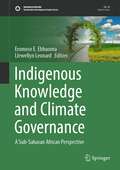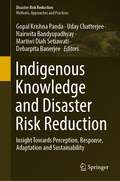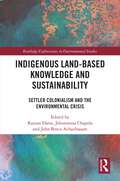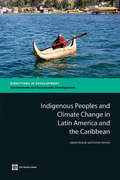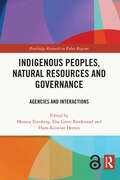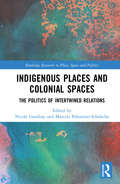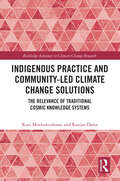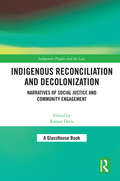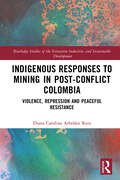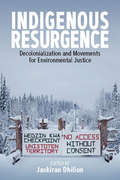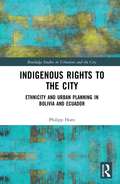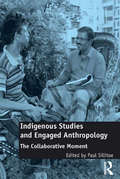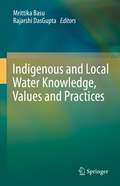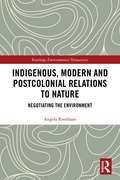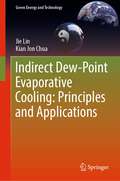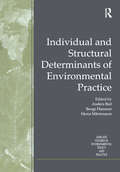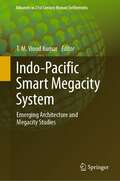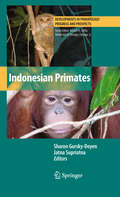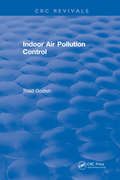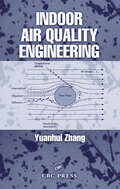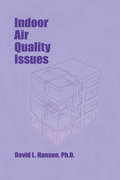- Table View
- List View
Indigenous Knowledge and Climate Governance: A Sub-Saharan African Perspective (Sustainable Development Goals Series)
by Llewellyn Leonard Eromose E. EbhuomaThis book investigates indigenous knowledge systems (IKS) in sub-Saharan Africa, thereby highlighting its role in facilitating adaptation to climate variability and change, and also demystifying the challenges that prevent it from being integrated with scientific knowledge in climate governance schemes. Indigenous people and their priceless knowledge rarely feature when decision-makers prepare for future climate change. This book showcases how Indigenous knowledge facilitates adaptation to climate change, including how collaborations with scientific knowledge have cascaded into building people’s resilience to climatic risks. This book also pays delicate attention to the factors fueling epistemic injustice towards Indigenous knowledge, which hampers it from featuring in climate governance schemes across sub-Saharan Africa. The key insights shared in this book illuminate the issues that contribute meaningfully towards the actualisation of the UN SDG 13 and promote mechanisms for raising capacity for effective climate change-related planning and management in sub-Saharan Africa.
Indigenous Knowledge and Disaster Risk Reduction: Insight Towards Perception, Response, Adaptation and Sustainability (Disaster Risk Reduction)
by Uday Chatterjee Nairwita Bandyopadhyay Martiwi Diah Setiawati Gopal Krishna Panda Debarpita BanerjeeThe book seeks to comprehend how indigenous knowledge systems of local communities can be effectively used in disaster management of various types. A prime example is the 2015 Sendai Framework for Disaster Risk Reduction, promoting indigenous environmental management knowledge and practices. Traditional knowledge of indigenous peoples includes information and insight that supplement conventional science and environmental observations, a comprehensive understanding of the environment, natural resources, culture, and human interactions with them which is not documented before. A great deal of this knowledge have been lost in translation. In this book, the authors attempt to keep a record of each and every traditional knowledge study of the indigenous communities in managing the disasters. The use of indigenous knowledge systems in disaster understanding and management is the primary focus of the chapters. This book is organized into four major sections. The first part gives an overview and help in conceptualizing the different concepts of hazard and disaster perception and how response and adaptation are connected with it. This part also discusses the concept of the connection between hazard and sustainable development and how the understanding of risk reduction and resilience can happen with the help of indigenous knowledge, insights, and strategies. The second part of the book introduces the different approaches to disaster and risk management. It establishes how vulnerability influences the risk associated with a hazard and the responses can be both positive and negative in disaster management. The approaches of the indigenous communities in managing a disaster, their resilience, capacity building, and community-based preparedness will be the area of prime focus in this chapter. Part 3 of this book describes the concept of sustainability through indigenous knowledge and practice. The sole highlight of this chapter is the indigenous knowledge efficacies in disaster identification, risk reduction, climate risk management, and climate action. The last section of the book explores how to meet the gaps between local knowledge and policy formulation. It highlights how traditional knowledge of the indigenous communities can prove to be beneficial in developing a holistic regional-based policy framework which will be easily accepted by the target stakeholders since they will be more acquainted with the local strategies and methods. This section ends with an assessment and discussion of the gaps and future scopes in disaster risk reduction through integrating local knowledge and modern technologies.
Indigenous Knowledge for Climate Change Assessment and Adaptation
by Igor Krupnik Douglas Nakashima Jennifer T. RubisThis unique transdisciplinary publication is the result of collaboration between UNESCO's Local and Indigenous Knowledge Systems (LINKS) programme, the United Nations University's Traditional Knowledge Initiative, the IPCC, and other organisations. Chapters, written by indigenous peoples, scientists and development experts, provide insight into how diverse societies observe and adapt to changing environments. A broad range of case studies illustrate how these societies, building upon traditional knowledge handed down through generations, are already developing their own solutions for dealing with a rapidly changing climate and how this might be useful on a global scale. Of interest to policy-makers, social and natural scientists, and indigenous peoples and experts, this book provides an indispensable reference for those interested in climate science, policy and adaptation.
Indigenous Land-Based Knowledge and Sustainability: Settler Colonialism and the Environmental Crisis (Routledge Explorations in Environmental Studies)
by Ranjan Datta Jebunnessa Chapola John Bosco AcharibasamThis edited volume explores the crucial intersections between Indigenous Land-Based Knowledge (ILK), sustainability, settler colonialism, and the ongoing environmental crisis.Contributors from cross-cultural communities, including Indigenous, settlers, immigrants, and refugee communities, discuss why ILK and practice hold great potential for tackling our current environmental crises, particularly addressing the settler colonialism that contributes towards the environmental challenges faced in the world. The authors offer insights into sustainable practices, biodiversity conservation, climate change adaptation, and sustainable land management and centre Indigenous perspectives on ILK as a space to practise, preserve, and promote Indigenous cultures. With case studies spanning topics as diverse as land acknowledgements, land-based learning, Indigenous-led water governance, and birth evacuation, this book shows how our responsibility for ILK can benefit collectively by fostering a more inclusive, sustainable, and interconnected world. Through the promotion of Indigenous perspectives and responsibility towards land and community, this volume advocates for a shift in paradigm towards more inclusive and sustainable approaches to environmental sustainability.This volume will be of great interest to students and scholars of environmental sociology, postcolonial studies, and Indigenous studies.
Indigenous Peoples and Climate Change in Latin America and the Caribbean
by Dorte Verner Jakob KronikThis book addresses the social implications of climate change and climatic variability on indigenous peoples and communities living in the highlands, lowlands, and coastal areas of Latin America and the Caribbean. Across the region, indigenous people already perceive and experience negative effects of climate change and variability. Many indigenous communities find it difficult to adapt in a culturally sustainable manner. In fact, indigenous peoples often blame themselves for the changes they observe in nature, despite their limited emission of green house gasses. Not only is the viability of their livelihoods threatened, resulting in food insecurity and poor health, but also their cultural integrity is being challenged, eroding the confidence in solutions provided by traditional institutions and authorities. The book is based on field research among indigenous communities in three major eco-geographical regions: the Amazon; the Andes and Sub-Andes; and the Caribbean and Mesoamerica. It finds major inter-regional differences in the impacts observed between areas prone to rapid- and slow-onset natural hazards. In Mesoamerican and the Caribbean, increasingly severe storms and hurricanes damage infrastructure and property, and even cause loss of land, reducing access to livelihood resources. In the Columbian Amazon, changes in precipitation and seasonality have direct immediate effects on livelihoods and health, as crops often fail and the reproduction of fish stock is threatened by changes in the river ebb and flow. In the Andean region, water scarcity for crops and livestock, erosion of ecosystems and changes in biodiversity threatens food security, both within indigenous villages and among populations who depend on indigenous agriculture, causing widespread migration to already crowded urban areas. The study aims to increase understanding on the complexity of how indigenous communities are impacted by climate change and the options for improving their resilience and adaptability to these phenomena. The goal is to improve indigenous peoples' rights and opportunities in climate change adaptation, and guide efforts to design effective and sustainable adaptation initiatives.
Indigenous Peoples and Climate Justice: A Critical Analysis of International Human Rights Law and Governance (Energy, Climate and the Environment)
by Giada GiacominiThis book provides a new interpretation of international law specifically dedicated to Indigenous peoples in the context of a climate justice approach. The book presents a critical analysis of past and current developments at the intersection of human rights and international environmental law and governance. The book suggests new ways forward and demonstrates the need for a paradigmatic shift that would enhance the meaningful participation of Indigenous peoples as fundamental actors in the conservation of biodiversity and in the fight against climate change. The book offers guidance on a number of critical intersecting and interdependent issues at the forefront of climate change law and policy – inside and outside of the UN climate change regime. The author suggests that the adoption of a critical perspective on international law is needed in order to highlight inherent structural and systemic issues of the international law regime which are all issues that ultimately impede the pursue of climate justice for Indigenous peoples.
Indigenous Peoples, Natural Resources and Governance: Agencies and Interactions (Routledge Research in Polar Regions)
by Monica Tennberg Else Grete Broderstad Hans-Kristian HernesThis book offers multidisciplinary perspectives on the changing relationships between states, indigenous peoples and industries in the Arctic and beyond. It offers insights from Nordic countries, Canada, Australia, New Zealand and Russia to present different systems of resource governance and practices of managing industry-indigenous peoples’ relations in the mining industry, renewable resource development and aquaculture. Chapters cover growing international interest on Arctic natural resources, globalization of extractive industries and increasing land use conflicts. It considers issues such as equity, use of knowledge, development of company practices, conflict-solving measures and the role of indigenous institutions. Focus on Indigenous peoples and Governance triangle Multidisciplinary: political science, legal studies, sociology, administrative studies, Indigenous studies Global approach: Nordic countries, Canada, Russia, Australia, New Zealand and Canada Thorough case studies, rich material and analysis The book will be of great interest to legal scholars, political scientists, experts in administrative sciences, authorities at different levels (local, regional and nations), experts in human rights and natural resources governance, experts in corporate social governance.
Indigenous Places and Colonial Spaces: The Politics of Intertwined Relations (Routledge Research in Place, Space and Politics)
by Nicole Gombay Marcela Palomino-SchalschaIn the aftermath of colonial occupation, Indigenous peoples have long fought to assert their sovereignty. This requires that settler colonial societies comprehend the inadequacy of their responses to Indigenous peoples’ contestations of existing power relations. Taking an international and contemporary perspective, this book critically explores the extent to which Indigenous peoples are transforming the conditions of their coexistence with settler colonial societies. With contributions from Indigenous and non-Indigenous researchers across the humanities and social sciences, the book is divided into four sections that reflect some key arenas of debate: ontological negotiations; assertions of connections to and rights over land; the contradictions embedded in practices of "recognition"; and the possibilities for change based on rightful relationships. From medicine to urban spaces, from love to alternative economies, from acts of citizenship to environmental justice, the chapters of this book provide a grounded analysis of how these spaces of intertwined coexistence are being crafted, resisted, reconfigured, and expanded. Providing concrete insight into the responses of Indigenous communities to the impacts of settler colonialism, this book will appeal to researchers in Cultural Geography, Anthropology, Rural Studies, Political Geography, Indigenous Studies, and Settler Colonial Studies.
Indigenous Practice and Community-Led Climate Change Solutions: The Relevance of Traditional Cosmic Knowledge Systems (Routledge Advances in Climate Change Research)
by Ranjan Datta Rani MuthukrishnanThis book centers Indigenous knowledge and practice in community-led climate change solutions. This book will be one of the first academic books to use the consciousness framework to examine and explain humans' situatedness and role in maintaining ecosystems' health. Drawing on teachings from the Indigenous Adi-Shaiva community, the authors present up-to-date research on meanings and implications of South Asian traditional cosmic knowledge, which focuses on relationality and spirituality connected to climate change. This knowledge can create innovative climate change solutions in areas including land, water, traditional management, sustainability goals and expectations, and state development projects. Overall, this book provides an innovative framework for nonviolent climate solutions, which has its foundations in a traditional cosmic and consciousness-based context. This book, which aims to bridge the gap between Indigenous and Western perspectives by re-educating researchers and decolonizing popular climate change solutions, will be of great interest to students and scholars studying climate change, conservation, environmental anthropology, and Indigenous studies on a broader scale.
Indigenous Practice and Community-Led Climate Change Solutions: The Relevance of Traditional Cosmic Knowledge Systems (Routledge Advances in Climate Change Research)
by Ranjan Datta Rani MuthukrishnanThis book centers Indigenous knowledge and practice in community-led climate change solutions.This book will be one of the first academic books to use the consciousness framework to examine and explain humans' situatedness and role in maintaining ecosystems' health. Drawing on teachings from the Indigenous Adi-Shaiva community, the authors present up-to-date research on meanings and implications of South Asian traditional cosmic knowledge, which focuses on relationality and spirituality connected to climate change. This knowledge can create innovative climate change solutions in areas including land, water, traditional management, sustainability goals and expectations, and state development projects. Overall, this book provides an innovative framework for nonviolent climate solutions, which has its foundations in a traditional cosmic and consciousness-based context.This book, which aims to bridge the gap between Indigenous and Western perspectives by re-educating researchers and decolonizing popular climate change solutions, will be of great interest to students and scholars studying climate change, conservation, environmental anthropology, and Indigenous studies on a broader scale.
Indigenous Reconciliation and Decolonization: Narratives of Social Justice and Community Engagement (Indigenous Peoples and the Law)
by Ranjan DattaThis book addresses the ethical and practical issues at stake in the reconciliation of Indigenous and non-indigenous communities. An increasing number of researchers, educators, and social and environmental activists are eager to find ways to effectively support ongoing attempts to recognize, integrate and promote Indigenous perspectives and communities. Taking Canada as its focus, this book offers a multidisciplinary consideration of a range of reconciliation policies, practices and initiatives that are relevant in all settler states. Set against its increasing neoliberal appropriation, the book resituates reconciliation in the everyday contexts of community interaction and engagement, as well as in the important areas of Indigenous knowledge, resource management and social and environmental justice. Reconciliation is not just the responsibility of law and government. And, attuned to the different perspectives of settlers, migrants and refugee communities, the book examines areas of opportunity, as well as obstacles to progress, in the forging of a truly decolonizing framework for reconciliation. As the challenges of reconciliation cross numerous academic and substantial areas, this book will appeal to a range of scholars and practitioners working in law, politics, education, environmental studies, anthropology and Indigenous studies.
Indigenous Responses to Mining in Post-Conflict Colombia: Violence, Repression and Peaceful Resistance (Routledge Studies of the Extractive Industries and Sustainable Development)
by Diana Carolina Arbeláez RuizThis book examines Indigenous responses to mining and their connection to peacebuilding, focusing on the experience of the Nasa Indigenous people of North Cauca during the most recent Colombian post-agreement transition. Amid an armed conflict that has disproportionally affected and targeted the Nasa, as well as ongoing processes of dispossession and oppression, the Nasa have built a tradition of organised, peaceful resistance. This book examines the nature of their responses to mining and how this is linked to peacebuilding, with a focus on how resistance is shaped and enacted to respond to the relationship mineral extraction has with violence and peace. The work is exploratory, ethnographic and interdisciplinary in nature, sitting in the intersection between the anthropology of mining, development studies and peace and conflict studies. The author presents and analyses narratives, participant responses, and her own experiences to illustrate the context and interconnected processes shaping Nasa responses to mining during this transition period. The book will bring international readers closer to these intricate dynamics, where access is otherwise limited because of security, cultural, linguistic and other barriers. The book provides a novel perspective on post-conflict mining governance by focusing on the Nasa’s active role in responding to mining in a post-agreement, transitional context. It highlights, and encourages engagement with, the often-overlooked role of morality in debates about nature and development. This book will be of great interest to students, scholars and practitioners of the extractive industries, natural resource management, conflict management and peacebuilding, Indigenous Peoples and Latin American studies.
Indigenous Resurgence: Decolonialization and Movements for Environmental Justice
by Jaskiran DhillonFrom the Standing Rock Sioux Tribe’s resistance against the Dakota Access pipeline to the Nepalese Newar community’s protest of the Fast Track Road Project, Indigenous peoples around the world are standing up and speaking out against global capitalism to protect the land, water, and air. By reminding us of the fundamental importance of placing Indigenous politics, histories, and ontologies at the center of our social movements, Indigenous Resurgence positions environmental justice within historical, social, political, and economic contexts, exploring the troubling relationship between colonial and environmental violence and reframing climate change and environmental degradation through an anticolonial lens.
Indigenous Rights to the City: Ethnicity and Urban Planning in Bolivia and Ecuador (Routledge Studies in Urbanism and the City)
by Philipp HornThis book breaks new ground in understanding urban indigeneity in policy and planning practice. It is the first comprehensive and comparative study that foregrounds the complex interplay of multiple organisations involved in translating indigenous rights to the city in Latin America, focussing on the cities of La Paz and Quito. The book establishes how planning for urban indigeneity looks in practice, even in seemingly progressive settings, such as Bolivia and Ecuador, where indigenous rights to the city are recognised within constitutions. It demonstrates that the translation of indigenous rights to the city is a process involving different actor groups operating within state institutions and indigenous communities, which often hold conflicting interests and needs. The book also establishes a set of theoretical, methodological, and practical foundations for envisaging how urban indigenous planning in Latin America and elsewhere should be understood, studied, and undertaken: As a process which embraces conflict and challenges power relations within indigenous communities and between these communities and the state. This book will appeal to practitioners, researchers, and students working within the fields of urban planning, urban development, and indigenous rights.
Indigenous Studies and Engaged Anthropology: The Collaborative Moment
by Paul SillitoeAdvancing the rising field of engaged or participatory anthropology that is emerging at the same time as increased opposition from Indigenous peoples to research, this book offers critical reflections on research approaches to-date. The engaged approach seeks to change the researcher-researched relationship fundamentally, to make methods more appropriate and beneficial to communities by involving them as participants in the entire process from choice of research topic onwards. The aim is not only to change power relationships, but also engage with non-academic audiences. The advancement of such an egalitarian and inclusive approach to research can provoke strong opposition. Some argue that it threatens academic rigour and worry about the undermining of disciplinary authority. Others point to the difficulties of establishing an appropriately non-ethnocentric moral stance and navigating the complex problems communities face. Drawing on the experiences of Indigenous scholars, anthropologists and development professionals acquainted with a range of cultures, this book furthers our understanding of pressing issues such as interpretation, transmission and ownership of Indigenous knowledge, and appropriate ways to represent and communicate it. All the contributors recognise the plurality of knowledge and incorporate perspectives that derive, at least in part, from other ways of being in the world.
Indigenous and Local Water Knowledge, Values and Practices
by Rajarshi DasGupta Mrittika BasuThis book provides a knowledge base of the existing indigenous and local water knowledge, values, and practices, and how this water knowledge can be mainstreamed into the decision-making process. The book not only demonstrates the perks of using indigenous knowledge but also illustrates the barriers and gaps that should be considered while planning for mainstreaming traditional knowledge and values at a local scale. The chapters incorporate case studies from various parts of the world demonstrating how indigenous, and religious and cultural values of water have translated into water use and conservation behavior among indigenous people ensuring resource sustainability over a long period of time. There has been global attention towards combining indigenous and local knowledge with new information and innovation to attain future water security. In this regard, this book is timely, relevant, and significant as it is the first attempt, as per the best of our knowledge, to publish a book that solely addresses indigenous and local knowledge, values, and practices regarding water management, quality monitoring, use, and conservation. With increasing emphasis on the inclusion of indigenous and local knowledge into natural resource governance and conservation by international agencies like the Intergovernmental Science-Policy Platform on Biodiversity and Ecosystem Services (IPBES), the proposed book will significantly contribute to the existing knowledge base and demonstrate the importance of mainstreaming indigenous water knowledge and practices into water governance and decision making. The UN SDGs, recognizing the significance of indigenous knowledge systems, emphasized its inclusion in most aspects and principles of SDGs. Apart from direct links with SDGs like zero hunger (SDG 2), no poverty (SDG 1), and climate action (SDG 13), indigenous and local knowledge system is considered to be directly connected to clean water and sanitation (SDG 6). The book will be useful to researchers and students in the field of indigenous knowledge and education, water governance, community-level planning, and water sustainability. The book can be referred to for postgraduate courses and beyond, as well as policymakers, conservationists, non-governmental organizations, development practitioners, and local government officials.
Indigenous, Modern and Postcolonial Relations to Nature: Negotiating the Environment (Routledge Environmental Humanities)
by Angela RoothaanIndigenous, Modern and Postcolonial Relations to Nature contributes to the young field of intercultural philosophy by introducing the perspective of critical and postcolonial thinkers who have focused on systematic racism, power relations and the intersection of cultural identity and political struggle. Angela Roothaan discusses how initiatives to tackle environmental problems cross-nationally are often challenged by economic growth processes in postcolonial nations and further complicated by fights for land rights and self-determination of indigenous peoples. For these peoples, survival requires countering the scramble for resources and clashing with environmental organizations that aim to bring their lands under their own control. The author explores the epistemological and ontological clashes behind these problems. This volume brings more awareness of what structurally obstructs open exchange in philosophy world-wide, and shows that with respect to nature, we should first negotiate what the environment is to us humans, beyond cultural differences. It demonstrates how a globalizing philosophical discourse can fully include epistemological claims of spirit ontologies, while critically investigating the exclusive claim to knowledge of modern science and philosophy. This book will be of great interest to students and scholars of environmental philosophy, cultural anthropology, intercultural philosophy and postcolonial and critical theory.
Indirect Dew-Point Evaporative Cooling: Principles and Applications (Green Energy and Technology)
by Kian Jon Chua Jie LinThis book systematically discusses state-of-the-art dew-point evaporative cooling and provides key insights into current research efforts and future research interests. Novel energy-efficient and environment-friendly cooling technologies are essential to reduce the sharply rising energy consumption and greenhouse gas emissions and achieve carbon neutrality. Conventional air-conditioners which adopt a vapor compression cycle are neither energy-efficient nor sustainable due to the use of compressors and chemical refrigerants, as well as their intrinsic coupling of sensible and latent cooling loads. With the merits of high energy efficiency and the ability to decouple cooling loads without using chemical refrigerants, indirect dew-point evaporative cooling provides an ideal alternative solution to air conditioning in a variety of applications. A comprehensive review of evaporative cooling and their underlying engineering challenges is included. Advanced engineering and modeling experience critical to the development of dew-point evaporative coolers are highlighted. The effective analysis techniques for dew-point evaporative coolers are documented, and their intrinsic characteristics captured by these methods are reported. Lastly, advanced dew-point evaporative cooling systems in various energy-connected applications are discussed by providing multiple case studies. Specifically targeted at HVAC engineers, thermal scientists, and energy-engineering researchers, this book will balance fundamental concepts, industrial applications, and leading-edge research. As this book provides readers with depth and breadth of coverage, it can also be used by graduate-level students in relevant fields.
Individual and Structural Determinants of Environmental Practice (Routledge Studies in Environmental Policy and Practice)
by Bengt HanssonDuring recent years, there has been a growing awareness that a better understanding of human activities and the behavioural components of environmental problems is needed. This volume brings together psychologists, philosophers, sociologists, historians of technology and economics, and management experts to identify and examine the rules and motives that govern the environmental behaviour of individuals, households, organizations and society as a whole. Illustrated with case studies from Scandinavia, it shows how behaviours with negative or positive environmental effects are often performed without such consequences in mind. The book discusses how change towards positive environmental behaviour often conflicts with deep-rooted habits as well as exploring the importance for environmental practice of different everyday contexts. By presenting this multi-disciplinary analysis, the volume provides a comprehensive understanding of how behavioural change in relation to the environment can come about and how this can be integrated in the political framework.
Indo-Pacific Smart Megacity System: Emerging Architecture and Megacity Studies (Advances in 21st Century Human Settlements)
by T. M. Vinod KumarThis book is an in-depth study of the Indo-Pacific region for effective interventions in the megacities system. First, based on several criteria, the region is identified as homogeneous country groupings of diversity, a multi-polar spatial system, and as program regions of QUAD and I2U2 for action programs and investment transcending many nations but mostly the ocean space of the Indo-Pacific, connecting all megacities sub-regions spatially and functionally. Then, the megacities with problems and prospects for economic integration are studied from the point of view of regional economics and international trade, and finally, the rural–urban interface with case studies of selected countries is presented. Prospects of systems of megacities and individual megacities for regional economies are designed. Existing interconnections through rail, air, and ocean of megacity systems, their capacity, performance, and potential are analyzed for emerging issues. International trade among the megacity systems/countries with emerging issues and barriers are presented. The mobility of money, goods, and services among the systems of megacities is analyzed. Rule-based diplomacy and other emerging options are discussed to sustain the above calls for a study of the Security of the Indo-Pacific region. Finally, the emerging architecture for megacity system governance is also presented.Out of 21 megacities in the Indo-Pacific, an in-depth study of a few in India and Japan in the Indo-Pacific region for effective economic interventions in the megacities system at the city level was studied. COVID-19 has affected most of the countries in the Indo-Pacific. With a contraction of GDP and a GDP growth rate negative, the number below the poverty level increased. Foreign Direct Investment is not forthcoming in any of these countries. Job creation becomes a priority in addition to public health concerns connected with COVID-19.
Indonesia's Rain Forests: Using Earth's Resources
by Moana AshleyRain forest ecology and conservation of natural resources for children.
Indonesian Primates
by Jatna Supriatna Sharon Gursky-DoyenIndonesia possesses the second largest primate population in the world, with over 33 different primate species. Although Brazil possesses more primate species, Indonesia outranks it in terms of its diversity of primates, ranging from prosimians (slow lorises and tarsiers), to a multitude of Old World Monkey species (macaques, langurs, proboscis moneys) to lesser apes (siamangs, gibbons) and great apes (orangutans). The primates of Indonesia are distributed throughout the archipelago. Partly in response to the number of primates distributed throughout the Indonesian archipelago, Indonesia is classified as the home of two biodiversity hotspots (Wallacea and Sundaland). In order to be classified as a hotspot, an area must have a large proportion of endemic species coupled with a high degree of threat including having lost more than 70% of its original habitat. Two areas within Indonesia meet these criteria. The tremendous diversity of primates in Indonesia, in conjunction with the conservation issues facing the primates of this region, created a need for this volume.
Indoor Air Pollution Control
by Thad GodishThis is an all new book designed to provide you the practical information and data you need for indoor air pollution control! Presented early in the book is theory as support for the applications that follow; including a synthesized review of the significant literature on controlling air pollution. Practical applications-largely from the author's own experience-deal with 1) How to conduct indoor air quality investigations in both residences and public access buildings, 2) Indoor air quality mitigation practice, and 3) Case histories. This book will be very useful to consultants and other professionals who grapple to solve real world problems. And it will make an excellent textbook for new courses in indoor air quality. Indoor Air Pollution Control will be used for control and prevention of contaminated air in homes, apartment buildings, office buildings (large and small), hospitals, auditoriums, and other public buildings.
Indoor Air Quality Engineering
by Yuanhui ZhangIndoor Air Quality Engineering covers a wide range of indoor air quality engineering principles and applications, providing guidelines for identifying and analyzing indoor air quality problems as well as designing a system to mitigate these problems. Structured into three sections - properties and behavior of airborne pollutants, measurement and sa
Indoor Air Quality Issues
by David L. HansenThis text examines problems such as microbial contamination, building design, ventilation systems and psychological effects. It uses a multi-disciplined approach in examining the causes and effects of the interactions between occupants and non-industrial environments. The text also provides the reader with a tool for diagnosing IAQ problems and effectively reducing them.
